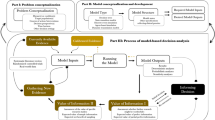Abstract
In the traditional ‘fix-it’ model of medical decision making, the identified problem is typically characterized by a diagnosis that indicates a deviation from normalcy. When a medical problem is multifaceted and the available interventions are only partially effective, a broader vision of the health care endeavor is needed. What matters to the patient, and what should matter to the practitioner, is the patient's future possibilities. More specifically, what is important is the character of the alternative futures that the patient could have and choosing among them so as to achieve the best future possible, with the ranking of outcomes determined by the patient's preferences. This paper describes the fix-it model, presents and defends the outcomes-based model, and demonstrates that the latter is useful in developing normative conceptions of informed consent and decision making and in establishing a basis for societal involvement in the decision making process. Finally, several shortcomings of the model will be acknowledged.
Similar content being viewed by others
References
Feinberg J. Harm to Others: The Moral Limits of the Criminal Law. Oxford: Oxford University Press, 1984.
Regan T. The Case for Animal Rights. Berkeley: University of California Press, 1983.
DeGrazia D. Interests, Intuition, and Moral Status. [Dissertation]. Washington, DC: Georgetown University, 1989.
Hippocrates. The art. [Transl Jones WHS]. In: Reiser SJ, Dyck AJ, Curran WJ, eds. Ethics in Medicine: Historical Perspectives and Contemporary Concerns. Cambridge: The MIT Press, 1987: 5–9.
Lidz CW, Meisel A. Informed consent and the structure of medical care. In: President's Commission for the Study of Ethical Problems in Medicine and Biomedical and Behavioral Research. Making Health Care Decisions: The Ethical and Legal Implications of Informed Consent in the Patient-Practitioner Relationship. Vol 2. Washington DC: US Government Printing Office, 1983: 317–410.
Katz J. The Silent World of Doctor and Patient. New York: The Free Press, 1984.
Eraker SA, Kirscht JP, Becker MH. Understanding and improving patient compliance. Ann Intern Med 1984; 100:258–68.
Rothert ML. Physicians' and patients' judgments of compliance with a hypertensive regimen. Med Decis Making 1982; 2:179–195.
DiMatteo RM, Friedman HS. Social Psychology and Medicine. Cambridge: Oelgeschlager, Gunn, & Hain, 1982.
Stimson GV. Obeying doctor's orders: a view from the other side. Soc Sci Med 1974; 8:97–104.
Faden RR, Beauchamp TL. A History of Informed Consent. New York: Oxford University Press, 1986.
Brody H. Transparency: informed consent in primary care. Hastings Cent Rep 1989; 19 (5):5–9.
Dworkin G. The Theory and Practice of Autonomy. Cambridge: Cambridge University Press, 1988.
Taylor WC, Pass T, Shepard DS, et al. Cholesterol reduction and life expectancy: a model incorporating multiple risk factors. Ann Intern Med 1987; 106:605–14.
Brett AS. Treating hypercholesterolemia: how should practicing physicians interpret the published data for patients? N Engl J Med 1989; 321:676–80.
Barry MJ, Mulley AG, Fowler FJ, Wennberg JW. Watchful waiting vs. immediate transurethral resection for symptomatic prostatism. JAMA 1988; 259:3010–17.
Fowler FJ, Wennberg J, Timothy RP, et al. Symptom status and quality of life following prostatectomy. JAMA 1988; 259:3018–22.
Roos N, Wennberg JE, Malenka DJ, et al. Mortality and reoperation after open and transurethral resection of the prostate for benign prostatic hyperplasia. N Engl J Med 1989; 320:1120–4.
Author information
Authors and Affiliations
Rights and permissions
About this article
Cite this article
Lynn, J., Degrazia, D. An outcomes model of medical decision making. Theor Med Bioeth 12, 325–343 (1991). https://doi.org/10.1007/BF00489892
Issue Date:
DOI: https://doi.org/10.1007/BF00489892




